
The capital and largest city in Sweden, Stockholm is globally renowned as a cultural, economic and technological hub, and as such, boasts a glut of fashionable cafés, world-class museums and marvelous palaces. It might come as a surprise but alongside Stockholm’s famous attractions are also dozens of unusual places and secluded nooks, still largely spared from the throngs of tourists who otherwise inundate the rest of the city.
An enjoyable sport for some while an utter nuisance for others, climbing stairs is often the only way of traversing Stockholm’s hilly parts. Luckily for pedestrians and cyclists who wish to skip the zillions of steps along David Bagares Street, the 20-meter deep Brunkeberg Tunnel provides an easy shortcut underneath the bustling streets of Norrmalm district.
Inaugurated in the late 19th century by the then Swedish king, Oskar II, the 231-meter-long passageway took a grueling effort to construct. To prevent landslides by the rocks across the soaking wet soil, a UK made freezer turned the surrounding earth into a -18°C frosty mass. Upon completion, using the passage entailed an entry fee of 2 Öre (equivalent to one fifth of a US cent), which amid public resentment was later revoked.
The tunnel was recently renovated after few years where it was left abandoned and fell into a state of disrepair. Its claustrophobia inducing dimensions (a 4-meter width and a 3.9-meter height) unexpectedly made it a trendy backdrop for photos among Instagrammers, yet despite its central location and unusual appeal, the tunnel largely remains an off-beat attraction.
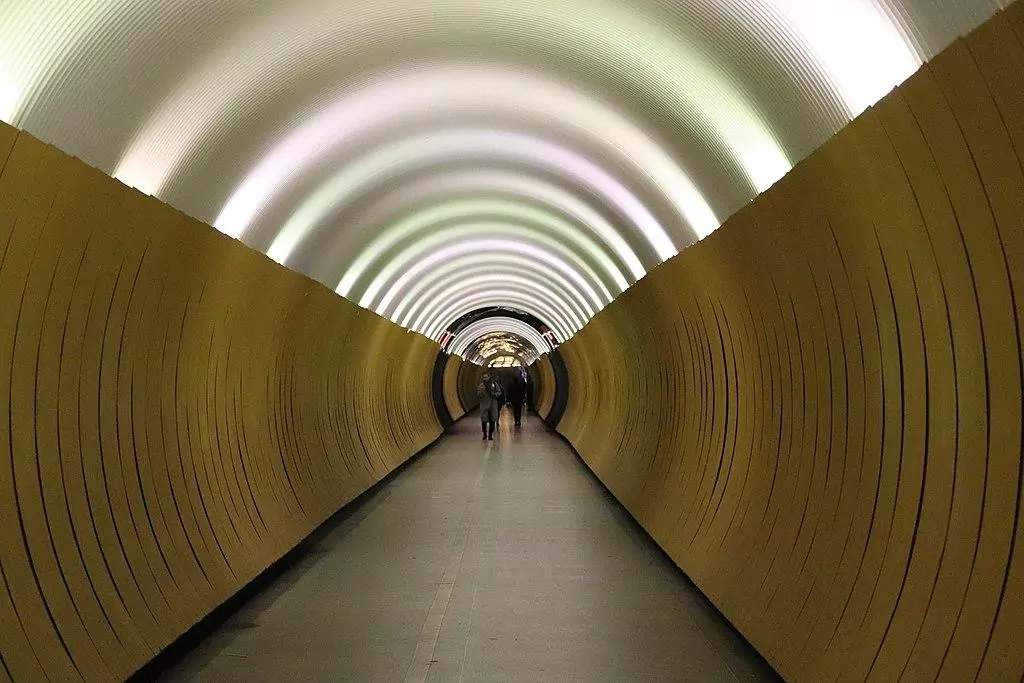
The claustrophobic Brunkeberg Tunnel
photography by: Wille Öhgren/ Wikimedia Commons
Beyond its urban core, Stockholm has scores of green spaces where locals flock to every weekend, particularly during the summer. One such getaway is Rosendals Trädgård, a cluster of interconnected gardens, formerly part of a royal complex. Located slightly south of the 19th century palace with which it still shares its name, the Rosendals gardens were originally created as an English Park in 1817, intended to be a peaceful nook for members of the royal family.
Over the course of the following decades, Rosendals Trädgård evolved into a horticultural center when the Swedish King endowed it with a greenhouse and an orangery, where tropical species of plants could flourish amid the country’s harsh winter. Soon after the park gained its cutting-edge facilities, the place turned into a gardening school, educating hundreds of gardeners along the years.
By the turn of the 20th century, when the horticulture academy was closed, the gardens became a shadow of their former selves. It wasn’t until the 1980’s, when the verdant hideaway was reborn as a center of biodynamic agriculture, an organic type of farming that excludes any use of artificial pesticides and fertilizers.
Today Rosendals Trädgård is home to a fruit orchard, wine garden, rose garden, bakery, several shops and a greenhouse-based café which serves food made from the park’s locally grown ingredients. Visitors can also wander around the park, strolling between pumpkin fields, the original orangery building and a charming labyrinth of manicured hedges.

A verdant field on the backdrop of the old orangery building
photography by: Tony Webster/ Wikimedia Commons
At 53 meters above sea level, Skinnarviksberget mountain is the highest natural point of elevation anywhere throughout downtown Stockholm, and as such, offers a stunning vista of the old town and Kungsholmen Island, including the iconic city hall building. Interestingly, its somewhat long name derives from the multiple tanneries which used to operate across the rocky hill during the mid-17th century.
Since skinning and tanning entails an incessant supply of freshwater while also emitting a sheer amount of unpleasant odors, the then isolated mountain along the Riddarfjärden Bay was an ideal location for that purpose. Nowadays, the savvy tanners are substituted by local Stockholmers who frequent the hilltop for sunset views, usually accompanied with a sip of beer.
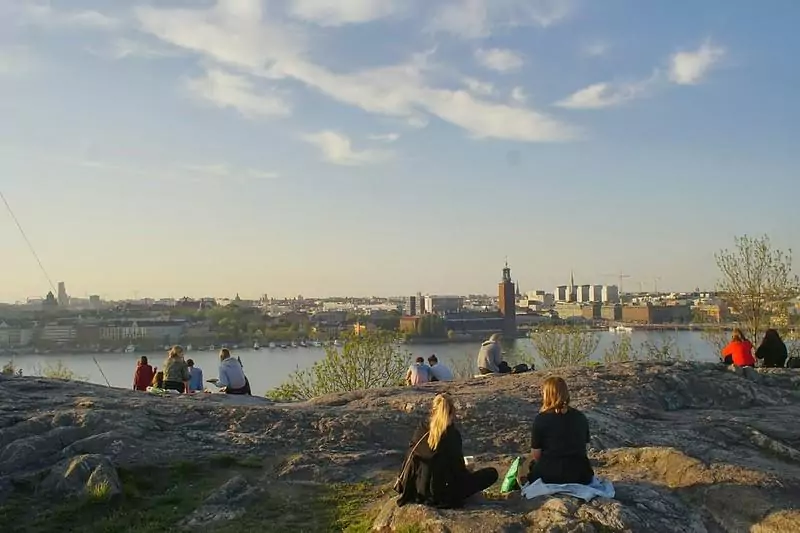
Stockholm city center as viewed from the top of Skinnarviksberget
photography by: One Trick Pony/ Flickr
When in 2011, the construction of 145-meter-tall twin towers in a northern district of Stockholm abruptly terminated due to a lack of fundings, Aleksander Wolodarski, the city architect who initiated the project, never imagined that his brainchild will be entirely redesigned a few years later. Constructed between 2013-2020 on top of the former project’s skeletal remnants, Norra Tornen, otherwise known as the Northern Towers, is a pair of residential high-rises that stand out for their unusual design.
Named “Helix”, the west tower is 110 meter tall and 33 floor high, while its eastern counterpart, the 125-meter tall and 36 floor high “Innovations”, became downtown Stockholm’s tallest building upon its inauguration in 2018. Designed by the famed Dutch architect, Rem Koolhaas, the towers’ 300 modular units are piled as if they were randomly stacked Tetris blocks. This bizarre, yet fascinating hodgepodge of flats was fashioned almost entirely from prefabricated concrete slabs. While the project’s residential units range from 44 to 271 square meters, each of which is bestowed with a large window, absorbing as much sunlight as possible given Sweden’s long and dark winters.
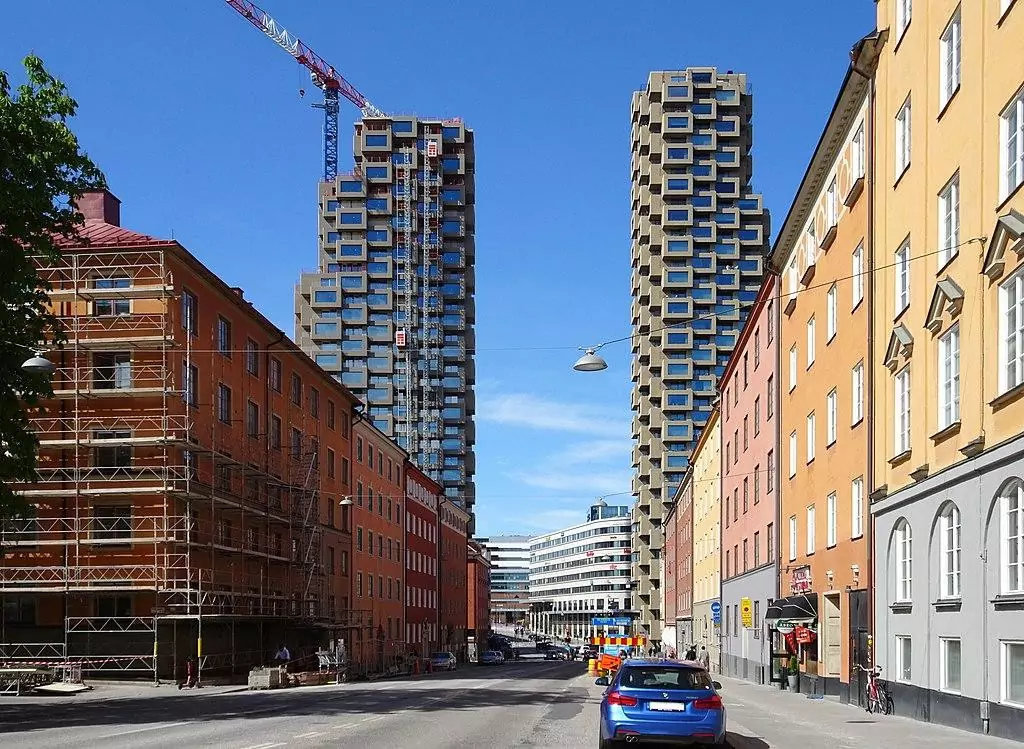
Norra Tornen under construction
photography by: Holger.Ellgaard/ Wikimedia Commons
During the late 19th century as the Swedish capital underwent a massive industrialization, the city was in dire need for gas to fuel its exponential growth. Luckily, the city council allocated large tracts of land in Hjorthagen, a northern district of Stockholm, where a series of gas production and storage facilities were constructed from 1890 onwards.
At its heyday, the gasworks, locally known as Värtagasverket, produced more than 240,000 cubic meters of gas per day, using ridiculously hot ovens where coal was gasified. Despite their utilitarian nature, the plant’s early structures were designed with utmost attention to details as architect Ferdinand Boberg created a couple of red-brick buildings, awash with ornaments such as arches and columns.
Perhaps one of Värtagasverket’s most conspicuous buildings was (and still is) the second gasometer. With a total capacity of a whopping 65,000 cubic meters, it was the largest gas holder in the world at the time of its completion in 1900. As the coal gas plant aged while its by-products were no longer sellable, it was replaced with a brand-new fission gas plant (using light petroleum instead of coal) in the late 1960’s, built slightly eastwards of the old complex.
Amid the country’s rapid transition into natural gas and biogas, the plant was deemed obsolete and decommissioned in 2011. There are ongoing efforts to transform the historic complex into a residential district with the intention of preserving some of the plant’s original buildings. Strolling between the area’s lavish red-brick buildings provides a fascinating perspective of the city’s bygone epoch, at least for the time being.

Värtagasverket's pair of giant gasholders
photography by: Holger.Ellgaard/ Wikimedia Commons
Originally, the verdant hill of Hammarbybacken in Björkhagen district towered merely 55 meters above sea level, which made it a modest knoll across the southern outskirts of Stockholm. Despite its rather unimpressive height, it had a couple of ski facilities, with some of which even hosting national ski contests.
When the area experienced a building frenzy during the 1980’s, this naturally formed mount began growing upwards as construction waste was dumped atop its grassy peak. Better known as Avicii Arena, the close-by “Globe” alone generated over 800,000 cubic meters of castoff materials which were enough to raise the mountain by more than 32 meters in 1989. Around 2007, additional waste from downhill Hammarby Lake City project helped Hammarbybacken reached its current height of 93.5 meters.
As of today, the waste heap serves as an urban ski resort during the winter and a scenic lookout during summertime. Since the site is surrounded by newly constructed projects that capture a great deal of heat, the ski slope gets regularly supplemented by a formidable snow canon that sprinkles the white flakes all over the hillside. As the hill borders a forested area, many hikers choose to climb to the top via a wooded trail. The summit itself is blessed with spectacular panoramic views of Stockholm city center as well as the looming countryside.
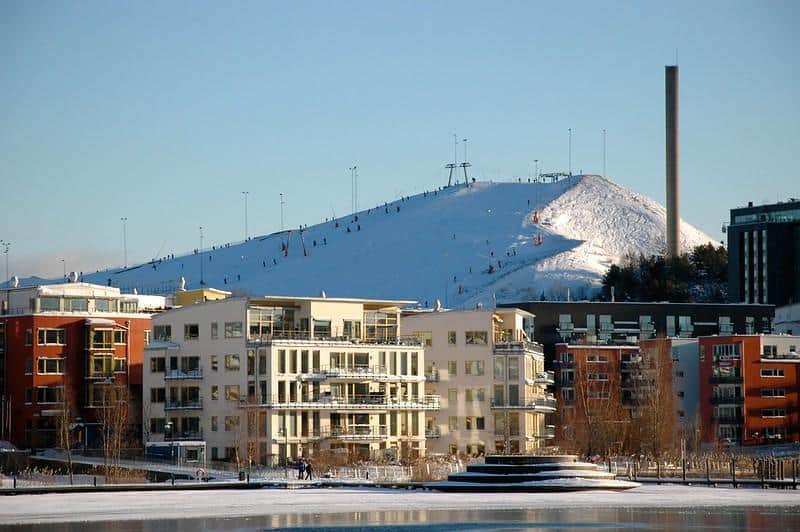
The snowcapped Hammarbybacken during wintertime
photography by: Joopey / Flickr
Well ensconced in the forested cemetery of Skogskyrkogården, Skogskapellet (translated as the Forest Chapel) might seem somewhat uninspiring at first glance. Nevertheless, a closer look will ultimately reveal myriads of creepy, yet awe-inspiring details that makes this tiny church far more interesting than one initially assumed.
When architect Gunnar Asplund was tasked with designing the chapel, he opted for stone as the main building material. However, after Asplund was told that his design won’t come into fruition due to a lack of funds, he went on a honeymoon with his wife to the Danish island of Møn, where he came across the Liselund Castle. The rural edifice immediately became his source of inspiration for a revised design of the church.
Located in a walled complex, dotted with pine trees, the rectangular chapel is topped by a dome, whose skylight floods the main hall with plenty of natural daylight. In stark contrast to its nondescript exterior and interior walls, the church is adorned with a couple of eerie ornaments as if it was a filming location of a horror movie. In fact, its intrepid visitors are first greeted by the Little Angel of Death, a morbid golden statue perching atop the vestibule’s roof, and an iron-clad gate, awash with grisly figures, most notably a skull-shaped keyhole.
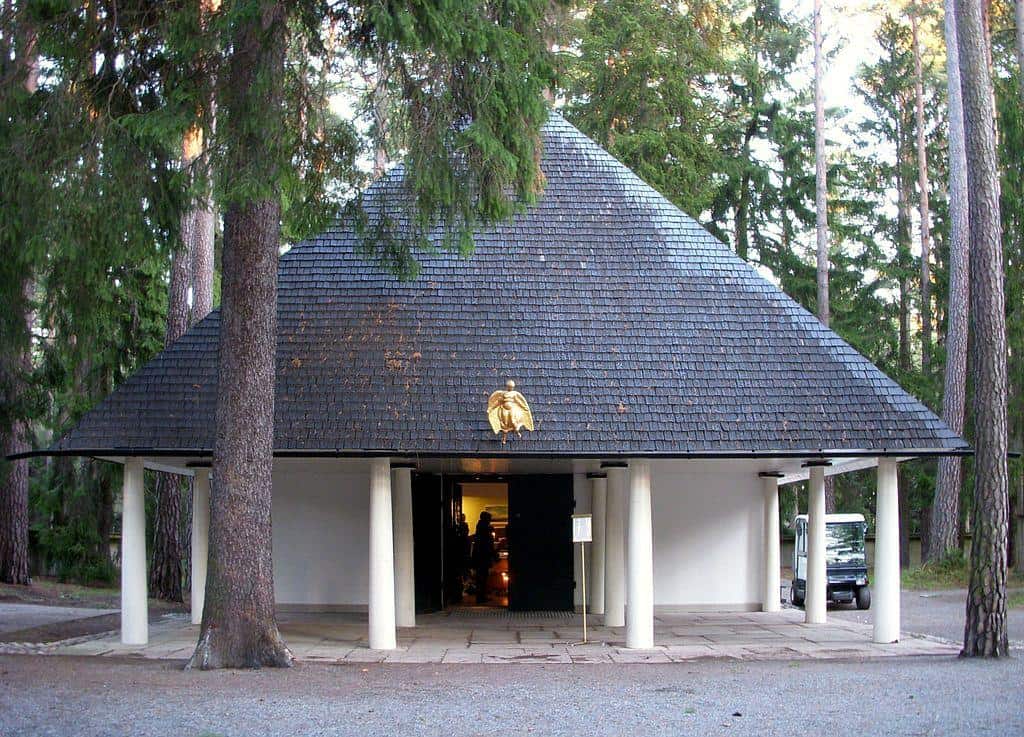
Skogskapellet's main façade, crowned with a golden statue of angel
photography by: Holger.Ellgaard/ Wikimedia Commons
Up until the summer of 2014, the cluster of shabby buildings along Snösätragränd Street was nothing more than an industrial wasteland. Determined to transform the otherwise decrepit area into an open-air museum, a group of local and international artists used the crummy walls as a canvas for their colorful works.
Ever since, this site at a rural corner of Stockholm is regularly frequented by graffiti artists who fill the surrounding façades with cheerful murals, depicting anything from futurist robots, exotic birds and superheroes to controversial political messages. Unofficially named Snösätragränd Hall of Fame, or Wall of Fame, the place also serves as a venue for street art events, where creators and ordinary people are given an opportunity to leave their mark.
While the breathtaking medley of murals constantly faces multiple threats of demolition and redevelopment, it has so far managed to dodge its impending demise. But since no one really knowns what the future holds for this place, the sooner you come, the better the chances of yours to witness its stunning works of art.
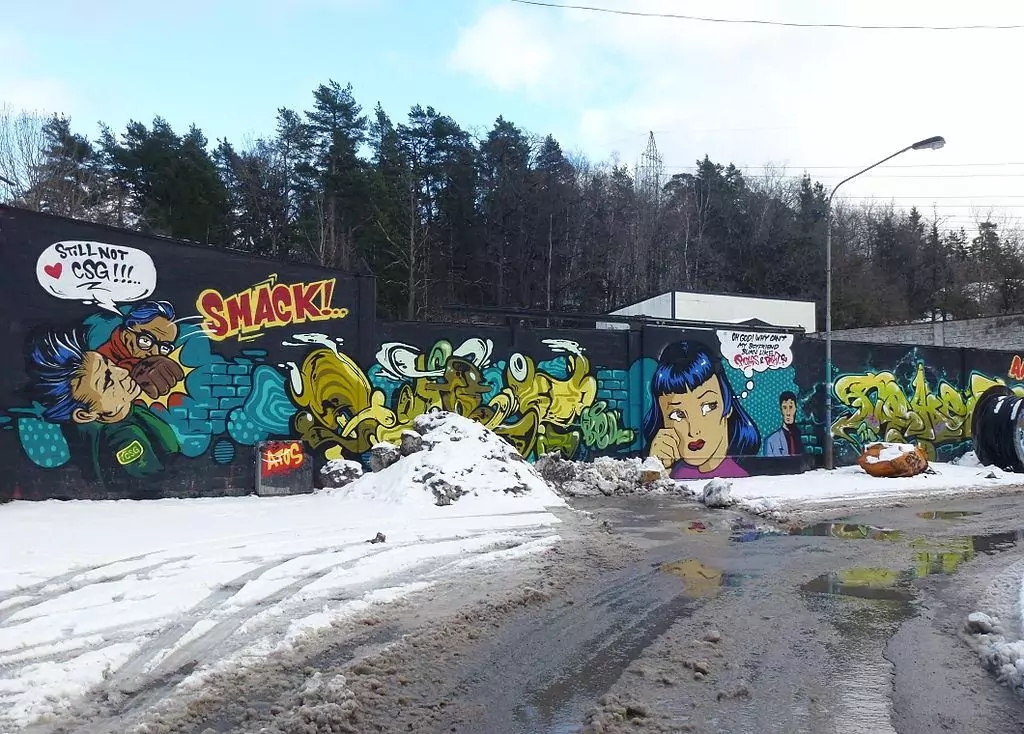
Snösätragränd's colorful murals
photography by: Holger.Ellgaard/ Wikimedia Commons